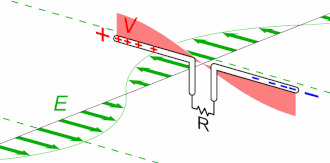Generation and reception

Radio waves are radiated by charged particles that are accelerated. Radio waves are produced artificially by time-varying electric currents, consisting of electrons flowing back and forth in a specially-shaped metal conductor called an antenna. An electronic device called a radio transmitter applies oscillating electric current to the antenna, and the antenna radiates the power as radio waves. Radio waves are received by another antenna attached to a radio receiver. When radio waves strike the receiving antenna they push the electrons in the metal back and forth, creating tiny oscillating currents which are detected by the receiver.
Comments
Post a Comment